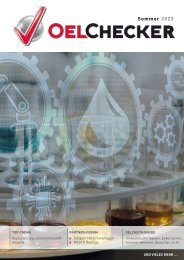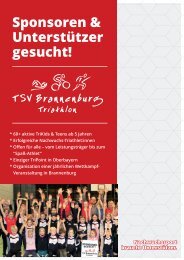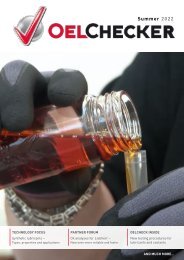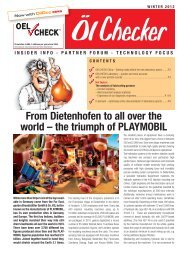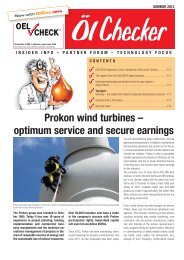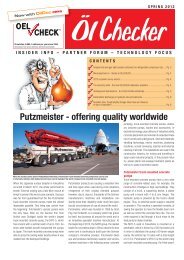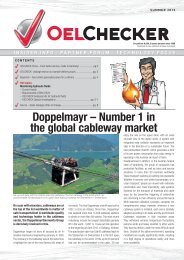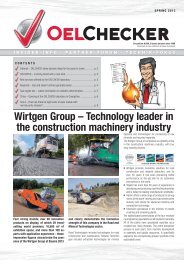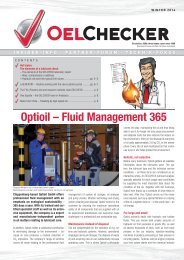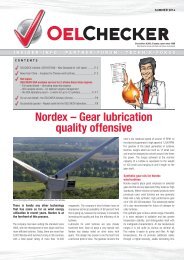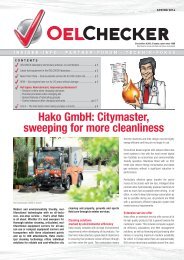OELCHECKER - Winter 2019
> Check-up – OELCHECK active in social networks > New analysis set for paper machines > Topping out ceremony for the largest OELCHECK building project to date > OELCHECK keeps growing – also globally > Employee event at Schliersbergalm > Technology focus: E-mobiles – Lubrication and cooling while electrified > How an electric vehicle works > Lubricants and coolants reinvented > OELCHECK challenged > Q&A: Can samples from other countries be examined by OELCHECK in Germany?
> Check-up – OELCHECK active in social networks
> New analysis set for paper machines
> Topping out ceremony for the largest OELCHECK building project to date
> OELCHECK keeps growing – also globally
> Employee event at Schliersbergalm
> Technology focus: E-mobiles – Lubrication and cooling while electrified
> How an electric vehicle works
> Lubricants and coolants reinvented
> OELCHECK challenged
> Q&A: Can samples from other countries be examined by OELCHECK in Germany?
You also want an ePaper? Increase the reach of your titles
YUMPU automatically turns print PDFs into web optimized ePapers that Google loves.
<strong>Winter</strong> <strong>2019</strong><br />
INSIDER INFO PARTNER FORUM TECHNOLOGY FOCUS<br />
CONTENT<br />
■ Check-up – OELCHECK active in social networks......................................................................................2<br />
■ New analysis set for paper machines........................................................................................................3<br />
■ Topping out ceremony for the largest OELCHECK building project to date...................................................3<br />
■ OELCHECK keeps growing – also globally.................................................................................................4<br />
■ Employee event at Schliersbergalm...........................................................................................................4<br />
■ Technology focus: E-mobiles – Lubrication and cooling while electrified<br />
– How an electric vehicle works<br />
– Lubricants and coolants reinvented<br />
– OELCHECK challenged.......................................................................................................................5-7<br />
■ Q&A: Can samples from other countries be examined by OELCHECK in Germany? ...................................... 8<br />
Össur – Life Without Limitations<br />
include orthopaedic technology, gait analysis, general<br />
mechanical engineering, hydraulics, pneumatics,<br />
CAD construction, materials science, plastics<br />
engineering, chemistry, textile engineering or also<br />
test technology and test station construction. The<br />
development site in Bayreuth operates a mechanical<br />
laboratory, an orthopaedic test workshop and a<br />
3D gait laboratory. Thus, user and processing tests<br />
as well as studies can be performed there.<br />
Prostheses are subsequently manufactured in<br />
medical facilities from modular fittings created by<br />
Össur. Suitable modules are installed with an individually<br />
manufactured prosthesis shaft in order<br />
to precisely adapt the prosthesis to the user’s<br />
requirements.<br />
Success with Össur – Paralympian Sarah Reinertsen holds the world records in sprint and marathon.<br />
Össur develops non-invasive prostheses<br />
and orthoses that allow its users to live<br />
a life without limitations. The company<br />
is familiar with the challenges that persons<br />
without limbs face on a daily basis<br />
and develops solutions in response. All<br />
technologies are continuously evaluated<br />
and improved. Lubricants are also central<br />
structural elements of mechanical prostheses<br />
joints, which is why these are critically<br />
examined by OELCHECK.<br />
Prosthesis fittings such as ankle or knee joints<br />
are small technical marvels. Össur develops all its<br />
products with the goal to allow as much natural<br />
functionality as possible for artificial limbs. The<br />
company operates five research and development<br />
centres in which comprehensive research is performed<br />
across various topical fields.<br />
Knowledge from various specialist fields must also<br />
be integrated into the German development facility<br />
in order to ensure that new products meet expectations.<br />
Among other things, these specialist areas<br />
Three million steps as a minimum<br />
requirement<br />
At Össur, each load-bearing fitting is dynamically<br />
tested for three million steps. Ultimately, prostheses<br />
fittings must perform reliably under all conditions<br />
in order to support the wearer in everyday<br />
life. In sports as well, countless sprinters, jumpers,<br />
throwers, triathletes, marathon runners and<br />
swimmers have been successfully equipped with<br />
Össur prosthesis fittings. Only prosthesis fittings<br />
for children must withstand greater stresses since<br />
a child may, e.g., climb a tree and then decide to<br />
jump down.
Check-up<br />
Christmas is fast approaching – which is also clearly evident in<br />
social networks. In fact, everyone seems to be talking about<br />
social media these days as it has become indispensable<br />
as a modern form of customer communication. Over three billion<br />
people worldwide are active in social networks. 38 % use these<br />
channels to find offers for products and services. We regard this as<br />
an opportunity to take a closer look at our profile as we aim to align<br />
the topic of social media with the overall company orientation.<br />
It is our daily motivation to achieve maximum customer satisfaction<br />
as an essential basis of our success. It is important for us to not only send but also receive<br />
content – social networks promote this kind of dialogue.<br />
We will therefore expand our communication activities and start our “social media offensive”.<br />
We will reinforce our presence on Facebook, LinkedIn, Xing and the like and also use Instagram<br />
as a new platform. We thereby create a variety of channels for our communications<br />
and give customers and potential customers a choice.<br />
The time has come in 2020: We are advancing our social media activity to the next level under the<br />
motto #OELCHECKGOESSOCIALMEDIA. Fresh new content will be played on new and old networks.<br />
Of course, we will continue to outwardly manifest our philosophy in a transparent and responsible<br />
manner – for our customers, partners, potential customers and employees.<br />
With this in mind, follow us!<br />
Sincerely, Barbara Weismann<br />
Fluid: Minimal volume and maximum<br />
performance<br />
Microhydraulics are filled with approx. 25 ml or<br />
three tablespoons of a special kind of hydraulic<br />
fluid. However, despite the little amount, the fluid<br />
provides optimal performance. The Össur Cheetah®<br />
Knee is also used by marathon runners,<br />
which suggest that the fluid is able to withstand<br />
tremendous stresses over a long period of time.<br />
Small bubbles with oxygenic air form when diffused<br />
air cannot quickly escape from the oil. Self-ignition<br />
occurs if these bubbles are highly compressed<br />
due to the high pressure that can occur within the<br />
hydraulics of a knee joint. The oil, which contains<br />
hydrocarbon reacts with the oxygen in the air bubbles.<br />
Analogous to the self-igniting diesel motor,<br />
isolated and incomplete combustion occurs due to<br />
insufficient oxygen. Soot particles form from this<br />
“diesel effect” that can give the oil a black colouration<br />
within a very short period of time.<br />
The toothed segment in the hydraulic chamber poses<br />
another challenge. Premature wear can occur if fluid<br />
performance is insufficient. Wear can even lead to<br />
breaks in the toothed segment and, in the worst-case<br />
scenario, block the joint causing the runner with the<br />
prosthesis to fall.<br />
2<br />
Microhydraulics in the knee joint<br />
The human knee is a highly complex joint. Stability<br />
and safety are the top priority when replacing the<br />
knee with a prosthesis fitting. However, the artificial<br />
knee should also move as physiologically as<br />
possible, which means that the lower leg on the<br />
side of the prosthesis should behave exactly as<br />
the still existing lower leg when moving at various<br />
speeds. For a majority of products, movements are<br />
controlled hydraulically. A small, fully configurable<br />
hydraulic cylinder performs similar tasks as the<br />
shock absorber of a vehicle. However, the cylinder<br />
does not absorb impacts but attenuates the rotational<br />
movement.<br />
The Bayreuth facility cooperates with OELCHECK<br />
since Össur regards hydraulic oil as a central structural<br />
element. For example, the hydraulic oils of two<br />
knee joints have already been subjected to certain<br />
examinations.<br />
The Össur Cheetah® Knee is one of these highly<br />
stressable joints with hydraulic swing phase control.<br />
It was specifically developed for quick flexing and<br />
extension while running and sprinting. The 4-axle<br />
geometry offers good stability in the standing phase<br />
as microhydraulics allow for the configuration of a<br />
maximum flexion angle, prevent hard impacts while<br />
extended and alleviate walking and the transition<br />
from walking to jogging or running.<br />
Microhydraulics installed in the Cheetah® Knee<br />
allow for a separate regulation of the attenuation<br />
degree in the flexion and extension direction via<br />
valves at the outside of the knee joint. The hydraulics<br />
chamber has a toothed rack combined with a<br />
toothed segment so that the linear piston movement<br />
can be converted into a rotational movement.<br />
Heat can build up quickly inside the artificial knee.<br />
The joint head can reach a temperature of up to<br />
80 °C during fast running, and joints would heat<br />
up even more without the cooling ribs in the lower<br />
joint area.<br />
OELCHECK supports development<br />
Safe functionality of hydraulic knee joints crucially<br />
depends on the used fluid. However, requirements<br />
placed on oils are consistently increasing as the<br />
trend is towards smaller, lighter and more efficient<br />
hydraulic units, which in turn exposes oils to greater<br />
pressures and temperatures.<br />
Össur cooperates with OELCHECK for each new<br />
development so that the optimal fluid is used right<br />
from the start. Many aspects are inspected during<br />
oil analysis. Among other things, the analysis also<br />
focusses on viscosity, viscosity temperature behaviour,<br />
EP wear protection, lubrication performance,<br />
pressure absorption and air output capacity, oxidation<br />
and ageing behaviour over a long period of<br />
time as well as compatibility with various materials<br />
and media.<br />
Össur – Industry innovation leader<br />
Founded in 1971, Össur is presently a market leader in<br />
non-invasive orthopaedics and the industry’s innovation<br />
leader. The company has a staff of over 3,000 employees<br />
who develop worldwide solutions for the requirements of<br />
users, orthopaedic engineers and medical staff. With headquarters<br />
in Iceland, the company also has a comprehensive<br />
global presence with additional sales centres in Europe,<br />
America, Asia and beyond. Össur operates according to<br />
strict and effective quality controls that comply with the<br />
requirements of ISO 9001 and ISO 13485 quality management<br />
standards.<br />
Further information at: www.ossur.com
OELCHECK INSIDE<br />
New analysis kit for paper machines<br />
Plant fibres are processed into pulp with water.<br />
The fibre pulp is sifted, drained, pressed and dried.<br />
The paper manufacturing process has changed<br />
since its beginnings. Today, modern machines are<br />
used for paper manufacture, producing endless<br />
paper webs around the clock in contrast to the<br />
manual process in which each sheet was created<br />
individually.<br />
The machines used today produce 1,800 meters of<br />
paper per minute under extreme conditions. Used<br />
lubricants are exposed to an air humidity of 90 %,<br />
an ambient temperature of up to 80 °C and fine<br />
paper dust. The oil volume of a paper machine<br />
will often hold more than 10,000 litres of oil in<br />
order to ensure long oil change intervals. However,<br />
oil-related machine malfunctions cause large-scale<br />
economic damage not only due to long downtimes<br />
but also on account of the required oil change,<br />
which is why a regular analysis of used lubricants<br />
is important. OELCHECK recommends performing<br />
an oil change every three months.<br />
OELCHECK now offers a special analysis kit for<br />
the optimal monitoring of gear oils, circulating<br />
oils, hydraulic fluids, heat transfer oils and greases<br />
for paper machines. The set with a mint green<br />
cap has the appropriate analysis scope – for any<br />
component.<br />
All-inclusive analysis kit for all paper machine applications<br />
Test result/procedure<br />
Gear<br />
We have already created these kind of industry<br />
solutions for gas motors and wind power stations.<br />
Based on broad approval from our customers with<br />
respect to previous innovations, we have now decided<br />
to expand these products to paper machines.<br />
Of course, you can continue to use your previously<br />
acquired analysis kits.<br />
Circulating<br />
lubrication Hydraulics Heat transfer oil Grease<br />
PQ index ü ü ü ü ü<br />
Visual evaluation ü ü ü ü ü<br />
Element analysis of up to 30<br />
elements<br />
ü ü ü ü ü<br />
Oxidation ü ü ü ü<br />
IR spectrometry ü ü ü ü ü<br />
IR index ü ü ü ü ü<br />
Viscosity at 40 and 100 °C, VI ü ü ü ü<br />
Flash point (closed)<br />
ü<br />
Water with FT-IR (%)<br />
ü<br />
Water according to K. F. (ppm) ü ü ü ü<br />
Neutralisation number ü ü ü<br />
Particle count ISO 4406,<br />
cleanliness class<br />
ü ü ü<br />
Topping out ceremony for the largest OELCHECK building project<br />
to date – completion is planned for April 2020<br />
The most extensive OELCECK building project to<br />
date is now in its final stages: The topping out ceremony<br />
was held in the prospective new company<br />
building at Kerschelweg 18. Construction began<br />
in April <strong>2019</strong> – the roof structure was completed<br />
in September.<br />
“It has almost become a tradition for OELCHECK<br />
to celebrate a topping out ceremony every five<br />
to seven years,” said builder-owner Peter Weismann<br />
at the beginning of his ceremonial address.<br />
He gave a chronological outline of the individual<br />
building phases and expressed his gratitude to the<br />
companies, architects and government agency<br />
representatives who were involved in construction.<br />
Mayor of Brannenburg Matthias Jokisch was also<br />
in attendance.<br />
After the traditional topping out speech given by<br />
the carpenter, all guests enjoyed burgers and beer –<br />
with live music by the Hinterberger Musikanten.<br />
The topping out ceremony also gave us an opportunity<br />
to thank the residents for their understanding<br />
in regard to all the construction work that had<br />
taken place.<br />
The floor finish will be installed just before Christmas<br />
if everything goes according to plan. The<br />
building is to be completed by April 2020.<br />
3
OELCHECK INSIDE<br />
OELCHECK keeps growing – also globally<br />
We have implemented personnel changes in order<br />
to cope with new eventualities on account of our<br />
increasingly global orientation and rising sample<br />
numbers – not only from abroad.<br />
Carsten Heine, previously Head of Tribology<br />
Team, is taking over the new<br />
position of “Technical Support<br />
Manager”. Mr Heine has been<br />
with OELCHECK since 2002. He<br />
initially worked for the company<br />
as a tribologist. Time and again,<br />
he supported our partner OilDoc as a<br />
competent advisor. Mr Heine then became Head of<br />
Tribology Team. He not only possesses wide-ranging<br />
technical and tribologist expertise but also has<br />
comprehensive knowledge of all processes that<br />
are performed at OELCHECK.<br />
As “Technical Support Manager”, Carsten Heine<br />
now supports the majority of our customers and<br />
our growing network of exclusive agents. He is the<br />
internal contact partner for technical queries from<br />
the Sales Team and provides support for technical<br />
customer consultation. He also supports our international<br />
exclusive agents in word and deed directly<br />
on-site and from the office in Brannenburg.<br />
We presently have exclusive agents in China, Russia<br />
and Taiwan. Moreover, we are in discussion<br />
with other partners since our international business<br />
is to be further expanded with additional<br />
agents. Therefore, finding the perfect person to fill<br />
the position of “Technical Support Manager” was a<br />
very important step.<br />
Dipl.-Ing. (UAS) M. Eng. Norman<br />
Rohrwick is taking over<br />
Head of Tribology Team.<br />
After his studies of mechanical<br />
engineering, Mr Rohrwick<br />
was a technical officer<br />
in the German navy. He then<br />
worked for the Bundeswehr in the<br />
area of damage analytics and condition monitoring.<br />
Since 2016, he has worked at OilDoc as an advisor<br />
for seminars, workshops and online training measures<br />
– predominantly with the focal points of motor<br />
and gear oils, machine monitoring via oil analyses<br />
and oil sensors.<br />
He brings his extensive expertise in the areas<br />
of lubrication, proactive maintenance, condition<br />
monitoring as well as lubricant and operating fluid<br />
analyses to his new position. As Head of Tribology<br />
Team, he is responsible for technical management<br />
and human resource management of currently<br />
seven tribologists – all experts in the evaluation<br />
and assessment of oil analyses.<br />
The Tribology Team is one of the most important<br />
pillars of the company. For a meaningful evaluation<br />
of analysis values, it is always necessary for employees<br />
to follow the latest technical advancements<br />
on the lubrication market, regularly discuss, among<br />
other things, structural particularities of oil-lubricated<br />
components with component manufacturers<br />
and, of course, possess the ability to consistently<br />
further develop utilised analysis procedures.<br />
This is how we successfully established ourselves<br />
in the past as pioneers in the lubricant and operating<br />
fluid analysis industry and how we are consistently<br />
and successfully confronting new challenges<br />
in the present.<br />
“Employees for employees” at Schliersbergalm<br />
This year’s team event brought us to Schliersbergalm,<br />
an alpine pasture at an altitude of 1061 m. Spectacular<br />
vistas across Lake Schliersee and exciting workshops<br />
awaited us on this wonderful weekend.<br />
The rum workshop introduced another group to<br />
Caribbean liquor, which included various tasting<br />
rounds – all participants were delighted to discover<br />
the variety of tastes and aromas that rum offers.<br />
Rum was handed out; cocktails were mixed and<br />
coffee specialities prepared. All under the motto:<br />
“Employees for employees”. Everyone then celebrated<br />
and danced late into the night.<br />
One group learned to professionally prepare alcoholic<br />
and non-alcoholic cocktails from an experienced<br />
barkeeper.<br />
Another group enjoyed coffee in the barista course<br />
and prepared speciality coffees with a portafilter<br />
machine. The coffee expert also addressed the intricacies<br />
of creating the perfect creamy milk froth.<br />
Dumplings, steaks and salad for the evening buffet<br />
were prepared in the adventure cooking workshop<br />
where ingredients were kneaded, cut, minced and<br />
refined. A professional chef also offered tips and<br />
tricks.<br />
At dinner, colleagues presented the contents of the<br />
various workshops.<br />
Depending on fitness level and personal preference<br />
– the agenda for the next day included<br />
mountain-biking (with or without motor), hiking and<br />
Nordic walking. Whether relaxed on the e-bike or<br />
hiking on foot – we all enjoyed the idyllic autumn<br />
season around Lake Schliersee.<br />
A tremendously successful event all-around!<br />
4
OELCHECK TECHNOLOGY FOCUS<br />
E-mobiles – Lubrication and<br />
Cooling while Electrified<br />
The motto: “No more petrol!” Quiet, emission-free electric vehicles will dominate the streets in the future. Although<br />
e-mobiles no longer run on petrol or diesel, they still need lubricants and functional fluids. However, these lubricants<br />
are different from known classics.<br />
Tremendous expectations are placed on lubricant manufacturers and oil<br />
analysts with regard to the development and monitoring of new<br />
products.<br />
E-mobility is booming, and the current supply<br />
of hydrogen-powered fuel cells or alternative<br />
fuels will most likely not cover<br />
the demand in the next years. New<br />
registrations for battery-powered<br />
electric vehicles in Germany<br />
are still marginal. Approximately<br />
220,000 electric cars were<br />
registered on 1 November <strong>2019</strong>.<br />
However, numerous promotions and<br />
billions of investments from automotive<br />
manufacturers support the further development of<br />
e-mobility so that Germany no longer lags behind<br />
China and the US. The technological goal is ambitious.<br />
Vehicle manufacturers, suppliers, politicians<br />
and we as end consumers will be confronted with<br />
many questions and challenges in the next years.<br />
The more e-mobiles are on the road, the higher<br />
the demand for electricity. Control over the entire<br />
electrical grid must be optimised, and the network<br />
of charging stations must be expanded for comprehensive<br />
coverage. Charging times for batteries are<br />
to be further reduced and ranges maximised. The<br />
currently common lithium-ion battery exhibits high<br />
specific energy, but the worldwide sought-after<br />
metal is highly reactive. Its usage has many negative<br />
consequences for the environment and local<br />
population. Although used lithium-ion batteries<br />
can be recycled, the process remains extremely<br />
elaborate. The battery must be operated within a<br />
specific temperature range in order to achieve a<br />
long service life and optimal effectiveness of the<br />
vehicle. Other vehicle components also play a role.<br />
Battery, motor and<br />
command centre<br />
Electrical skateboards and hoverboards are among<br />
the smallest battery-operated means of transportation.<br />
Many engineers have borrowed from the<br />
structural design of these little speedsters in order<br />
to design their e-vehicles. The heaviest part, the<br />
battery, is placed centrally in a relatively low position.<br />
The “skateboard design” supports good<br />
roadholding, allows for a large wheel distance and<br />
ensures more space in the interior of the car.<br />
Electricity, sourced from a charging station, provides<br />
the power for movement and is stored onboard<br />
in one or multiple batteries that supply electricity<br />
to the drive. A separate low-voltage battery<br />
supplies smaller additional electric motors e.g. for<br />
electric windows, windshield wipers, air conditioning<br />
or the radio.<br />
A synchronous alternating current motor is installed<br />
as the electric drive. In simplified terms, the car is<br />
propelled in the following manner: The alternating<br />
current motor consists of two magnets – the stator<br />
and the rotor.<br />
The stator is fixed and provides a variable magnetic<br />
field by means of the alternating current.<br />
The rotating rotor consist of a permanent magnet<br />
or provides its magnetic field by means of direct<br />
current. Both magnets alternatingly attract and<br />
repel each other. The rotor turns, and this motion<br />
is transferred to the wheels via the gear. For an<br />
electric motor, the maximum torque is available for<br />
a comparably high speed range. However, speeds<br />
from 0 to over 200 km/h cannot be achieved merely<br />
with engine speed. A gear is required. Instead<br />
of a transmission with 4 to 10 gears, only a one<br />
to two-gear transmission is needed to cover the<br />
entire speed range.<br />
A battery with a capacity of 150 kWh as in the<br />
case of the Audi e-tron supplies energy to the<br />
electric motor. Charging a depleted battery with a<br />
common 3-kW household electrical socket would<br />
take several days. “Filing up” at a quick charging<br />
station with 50-kW power supply would still take<br />
30 minutes for a driving distance of approx. 150<br />
km. However, the first ultra-quick charging stations<br />
are being established along autobahn service<br />
stations at which an 80-% battery charge can be<br />
achieved during a coffee break.<br />
© fotomek<br />
The engine speed is regulated with power electronics<br />
via a “power pedal”. Power electronics are the<br />
“command centre of the e-car”, consisting of an inverter,<br />
a direct current converter and an electronic<br />
5<br />
© nosorogua
control unit. The direct current from the battery is<br />
converted into alternating current required by the<br />
motor. Power electronics control the alternating<br />
current frequency and thereby the engine speed<br />
and also regulate the electric amplitude and thus<br />
the motor output power.<br />
They also play an important role when braking.<br />
Kinetic energy is not wasted but recovered when<br />
the driver takes the foot off the pedal. The vehicle<br />
brakes by “recuperating”. The electric motor<br />
functions like a generator during recuperating or<br />
regenerative braking. Gained electricity is stored<br />
in the battery. The power electronics accordingly<br />
adapt the energy supply.<br />
Lubricants and coolants reinvented<br />
Specific clearances are provided by many automotive<br />
manufacturers for lubricants and coolants that<br />
are used in vehicles with petrol or diesel motors.<br />
Their requirements are taken into account in the<br />
specifications of the ACEA (European Automobile<br />
Manufacturers Association) and API (American Petroleum<br />
Institute).<br />
Although e-vehicles do not require motor oils, gear<br />
oils, lubricant oils and greases as well as coolants,<br />
e.g. for the battery, remain indispensable.<br />
However, these products must fulfil very specific<br />
requirements. No e-vehicle manufacturer to date<br />
has defined a generally valid clearance list with<br />
specifications for lubricants and coolants. Furthermore,<br />
OEMs are still pursuing different approaches<br />
for the design of their e-mobiles. Therefore, lubricant<br />
manufacturers cannot yet engineer oils and<br />
coolants that are universally compatible with all<br />
e-vehicles.<br />
New lubricants – new challenges<br />
■ Partially direct contact with electrical and/<br />
or electronic components<br />
■ Insulating effect in order to avoid short<br />
circuits and sparking<br />
■ Usage throughout the entire service life<br />
■ Compatible with copper, many plastics<br />
and seals<br />
An e-mobile requires battery coolant, automatic<br />
gear oil, brake fluid for the disc brakes and low-viscosity<br />
greases for the roller bearings of the electric<br />
motor but also for other small components such<br />
as windshield wipers, the seat adjustment or the<br />
central locking system.<br />
The number of existing types is not too great – but<br />
wholly new demands are placed on lubricants and<br />
coolants.<br />
Supply for the drive and auxiliary aggregates ranges<br />
from 30 volts to 1,000 volts AC (alternating current)<br />
or 60 volts to 1,500 volts DC (direct current). Utilised<br />
fluids and greases sometimes come in direct contact<br />
with electrical and/or electronic vehicle components<br />
and must be reliably insulated for the entire usage<br />
time in order to prevent short-circuits and sparking.<br />
Moreover, they must be compatible with copper, a<br />
variety of plastics and sealing materials.<br />
Battery requirements are demanding.<br />
The top priority is to keep the battery temperature<br />
in an optimal range so that e-cars can be operated<br />
at a high efficiency level. Desired chemical<br />
reactions within the battery and the battery power<br />
decrease at temperatures below 0 °C. However,<br />
the battery should also not become too hot. Batteries<br />
age quickly at temperatures above 30 °C,<br />
and irreparable damage can occur when exposed<br />
to temperatures over 40 °C. Only batteries that<br />
are operated in a moderate temperature range<br />
from 15 to 30 °C can perform adequately over a<br />
long period of time, thereby fulfilling up to approximately<br />
70 % of the range stated in the brochure. A<br />
well-functioning thermal management system is<br />
indispensable in order to ensure that the battery<br />
can even go that far.<br />
Wheel bearings<br />
Air conditioner<br />
© teksomolika<br />
Vehicle manufactures pursue different paths in<br />
order to achieve this goal:<br />
• Thermal management of the battery management<br />
or battery pack can be realised by means<br />
of an air conditioner coolant circuit. A cooling<br />
plate is installed for the condenser and evaporator<br />
of the air conditioner. Its supply with air<br />
conditioner coolant is controlled separately via<br />
valves and temperature sensors. A power-consuming<br />
auxiliary heater ensures that the temperature<br />
does not sink too low in the winter.<br />
• A complex cooling and coolant system with several<br />
coolant circuits and separate components<br />
is often used for highly powerful batteries over<br />
100 kWh. The coolant circuit of the air conditioner<br />
is integrated in the cooling of the battery. An<br />
additional heater heats the coolant and battery<br />
in low temperatures. The system is most often<br />
filled with a water-glycol mixture whose formulation<br />
deviates from previously known coolants.<br />
• Tesla is pursuing a different path: More than<br />
7,000 individual cylinder-shaped lithium-ion<br />
cells are installed in the Model S with an 85-<br />
kWh battery pack. The internal chemical composition<br />
and the linking as well as the charging and<br />
discharging of individual cells are specifically<br />
designed for long-distance electric cars used by<br />
Californians. Individual cells are directly flooded<br />
with special coolant.<br />
Nowadays, classic coolants that are based on glycol<br />
concentrates and mixed with lots of water are<br />
only seldom used. The industry has developed new<br />
cooling fluids for the special conditions of e-mobiles<br />
that, e.g., contain water mixed with paraffin,<br />
glycol and surfactants. The direct cooling of battery<br />
cells is optimised with a higher storage density<br />
and transport capacity.<br />
Roller bearings<br />
in the e-motor<br />
Central locking system and other<br />
sensor motors<br />
Gear<br />
ABS/ESP<br />
6<br />
© Sonulkaster
OELCHECK TECHNOLOGY FOCUS<br />
Three key components<br />
Battery-fed power electronics, the e-motor and<br />
automatic transmission – these are the three key<br />
components of an electric drive train. It makes<br />
sense to combine these within a common casing in<br />
order to reduce costs and weight. This also makes<br />
it possible to supply them more easily with a single<br />
fluid, an innovative e-drive fluid. However, this is<br />
easier said than done. The gear must be lubricated<br />
to ensure low wear and abrasion. The other components<br />
especially require heat dissipation. Some<br />
renowned lubricant manufacturers have already<br />
developed special fluids with a cooling function<br />
that also lubricate the gear. These e-drive fluids<br />
must be extremely thin as efficient thermal dissipation<br />
is needed but also because the input speed of<br />
the gear is most often higher than 10,000 revolutions<br />
per minute. Its viscosity roughly corresponds<br />
to that of diesel fuel. General information about the<br />
formulation of these products cannot be currently<br />
provided. Engineers are feverishly working on developing<br />
innovative e-drive fluids. However, mineral<br />
oils or mineral-oil mixable synthetic oils are hardly<br />
used as a basis for pilot projects, but rather water<br />
mixtures with more than 50 % consisting of other<br />
components, silicone oils or glycols.<br />
E-drive fluids must cope with a whole range of<br />
electrical, thermal, tribologist and chemical challenges.<br />
They must perform under high voltage<br />
while directly contacting copper components,<br />
elastomers of seals and insulating varnish within<br />
the e-motor. These fluids must not absorb water<br />
in order to retain a high dielectric strength and<br />
thereby prevent electric arcing between live parts.<br />
Special challenges arise with respect to compatibility<br />
between liquid and various materials – most<br />
of all copper. Copper’s high electric conductivity<br />
makes it the most important but also critical component<br />
for all live lines as well as for the coils in the<br />
e-motor. E-drive fluids are to be highly compatible<br />
with copper.<br />
Not only the batteries, but also the power electronics<br />
and the electric motor must work within a<br />
© pgottschalk<br />
moderate temperature range. It is imperative that<br />
e-drive fluids provide efficient heat dissipation<br />
for temperatures up to 180 °C. Operation above<br />
the maximum temperature necessarily reduces<br />
the service life, efficiency level and range of the<br />
vehicles.<br />
However, extremely low-viscous e-drive fluid is not<br />
only responsible for the electric motors, but also contributes<br />
to securing the power transfer via the transmission.<br />
Many requirements must be fulfilled. Reliable<br />
lubrication, protection against wear and corrosion,<br />
high ageing stability, high material compatibility and<br />
a minimal tendency for foam formation must be ensured.<br />
Thus far, only lubricating oils whose viscosity is<br />
more than 10 times higher than the newly developed<br />
e-oils have exhibited these qualities.<br />
Braking saves power<br />
Modern electric vehicles are predominately moved<br />
over longer distances with the accelerator pedal. If<br />
the driver takes the foot off the pedal, the vehicle<br />
brakes automatically as kinetic energy is recovered.<br />
Since braking is somewhat time-delayed, e-mobiles<br />
are additionally equipped with conventional<br />
disc brakes. According to the manufacturer’s specifications,<br />
these require the classic brake fluid DOT<br />
4 or DOT 5.1, which mainly consists of temperature-stable<br />
polyglycolic compounds. In some case,<br />
the silicone-containing brake fluid DOT 5 is to be<br />
used, which may not be mixed with other types.<br />
New challenges for lubricating greases<br />
Most bearings, gear motors, hinges, guides or<br />
other small components in a vehicle only work with<br />
a service-life lubricating grease. An e-mobile requires<br />
approximately 2 to 3 kilograms of various<br />
lubricating greases. The greases must fulfil very<br />
specific conditions at some grease points especially<br />
if they contact electronic components, electric<br />
currents and electromagnetic fields. Furthermore,<br />
compatibility with protective varnishes, soft plastics<br />
and copper is additionally required at some<br />
grease points. Lubricating grease for roller bearings<br />
within electric motors is subject to especially<br />
high requirements due to high temperatures and<br />
speeds. The grease must not only provide reliable<br />
lubrication, but also reduce noise and vibrations!<br />
OELCHECK challenged<br />
The automotive industry is currently reinventing itself.<br />
The environment of the supplier industry is<br />
changing dramatically. Lubricant manufactures are<br />
also affected. The demand for customary motor oils<br />
will significantly decrease in the next years. At the<br />
same time, manufacturers must adapt parts of their<br />
production to totally new lubricants and coolants for<br />
e-vehicles. However, standardised specifications for<br />
e-mobile lubricants have not yet been defined. Various<br />
approaches are being pursued that do not allow<br />
for standardised specifications. Long-term experience<br />
values in regard to the behaviour of new lubricants<br />
and coolants based on long-term usage are not yet<br />
available.<br />
Lubricant analytics plays a decisive role under<br />
these conditions. Comprehensive expertise, practical<br />
experience and the highest degree of flexibility<br />
is demanded of OELCHECK. OELCHECK is actively<br />
participating in the new DIN committee “Electric<br />
properties of oils”. The committee deals with<br />
changes to operating fluids due to electrical properties<br />
that affect lubricants in the area of e-mobility.<br />
We are also contributing our expertise for the research<br />
project “High-voltage suitable e-drive oil” of<br />
FVA (Forschungsvereinigung Antriebstechnik e.V.).<br />
Although standardised analysis and evaluation<br />
methods for lubricant changes of e-mobiles have<br />
not yet been developed, we are already providing<br />
significant assistance to OEMs with respect<br />
to batteries and gears, test station operators and<br />
lubricant manufacturers. Discussions are currently<br />
being held about expected speeds, temperature<br />
stresses, insulation capacities as well as wear and<br />
additional requirement scenarios. We will soon<br />
have significantly more practical usage data at our<br />
disposal with regard to the behaviour of e-drive fluids,<br />
greases and coolants. Based on the results of<br />
our laboratory examinations, practical experience<br />
and the expertise of our tribologists, we will then<br />
decide which of our test methods is to be adapted<br />
for the evaluation of e-mobile lubricants and operating<br />
materials and which threshold values apply<br />
for the estimation of remaining usage time.<br />
OELCHECK is still focused on lubricants and operating<br />
fluids for electric cars. However, initial consultations<br />
with manufacturers of electrically operated<br />
omnibuses and lorries are already ongoing.<br />
7
We have commissioned OELCHECK for<br />
many years with the analysis of lubricant<br />
samples from our facilities in Germany.<br />
Our representatives currently use laboratories<br />
based in the respective country<br />
for lubricants that are used abroad. Unfortunately,<br />
we are neither satisfied with<br />
the quality (large deviations for trend<br />
analyses) nor the scope of the analysis. An<br />
option to enter the determined values in<br />
our own database in Germany is also not<br />
envisaged, and a well-founded diagnosis<br />
of the values is not provided.<br />
Can OELCHECK in Germany examine<br />
samples from other countries?<br />
OELCHECK:<br />
Of course. OELCHECK in Germany can analyse<br />
and examine samples from all over the world.<br />
Many of our customers who use their machines<br />
worldwide send their samples directly to us from<br />
abroad.<br />
All determined values are collected in a joint customer<br />
database. Moreover, you can also receive<br />
a notification, e.g. during the warranty time, to<br />
inform you whether the lubricant recommended<br />
by the manufacturer is being used.<br />
The OELCHECK laboratory regularly analyses<br />
significantly more values than nearly all other<br />
lubricant analysis laboratories, which is why we<br />
are able to detect more correlations and causes<br />
in case of unexpected results. Other laboratories<br />
often lack suitable threshold values in order to<br />
provide meaningful comments, and comments<br />
often only contain simple statements written by<br />
chemists and not – as at OELCHECK – by tribologists<br />
or mechanical engineers. Thus, competitors<br />
will issue short comments such as: “The iron<br />
value has risen.” Well, you do not need to be an<br />
expert to see that...<br />
Q&A<br />
<strong>Winter</strong> <strong>2019</strong><br />
An OELCHECK tribologist, on the other hand, will<br />
state that the iron value has risen due to corrosion<br />
as water, e.g. due to a pressure washer, has<br />
intruded into the lubrication system. He recognises<br />
this because, among other things, hardly<br />
any magnetisable iron (mechanical abrasion) is<br />
present and the presence of sodium and potassium<br />
additionally suggest “hard” tap water. You can<br />
recognise errors and initiate corrective measures<br />
or additional controls based on comments individually<br />
created for each sample.<br />
In contrast to the laboratories of most lubricant<br />
manufacturers or other competitors abroad, high<br />
German and international standards such as ISO<br />
17025 are consistently applied within our company.<br />
Analyses are performed quickly and accurately by<br />
experienced and trained laboratory employees who<br />
exclusively examine lubricating oils and greases,<br />
coolants and insulating oils<br />
Also with regard to samples shipped to us from<br />
abroad, you can rely on all-inclusive customary<br />
OELCHECK services such as the 24-hour service<br />
or mailing of laboratory reports via e-mail.<br />
Comments can be directly translated online – 15<br />
language are currently supported.<br />
How does it work?<br />
The procedure is essentially the same as for samples<br />
within Germany: Order the all-inclusive analysis<br />
kit, take the sample and send it to us by UPS.<br />
IMPRINT<br />
OelChecker – a magazine by OELCHECK GmbH<br />
Kerschelweg 28 · 83098 Brannenburg · Germany info@<br />
oelcheck.de · www.oelcheck.de<br />
All rights reserved. Reproduction only upon approval!<br />
Concept and text:<br />
OELCHECK GmbH · Astrid Hackländer<br />
Typesetting and design:<br />
Agentur Segel Setzen, Petra Bots, www.segel-setzen.com<br />
Photos:<br />
Össur · Adobe Stock · OELCHECK<br />
The easiest way is to contact our “Service & Sales”<br />
department (sales@oelcheck.de, Tel. +49 8034<br />
9047-250) prior to submitting your first order from<br />
abroad. You will receive an individual offer from<br />
us as well as the necessary documentation and<br />
papers that are required for smooth and quick shipping<br />
to Germany.<br />
In China, Taiwan or Russia (including CIS countries),<br />
our exclusive agents handle the entire<br />
process. Our agents on-site are experts in the<br />
lubrication industry and are familiar with technical<br />
terms, legal provisions and customers. In<br />
addition to consultation and the sale of all-inclusive<br />
analysis kits, they can also translate sample<br />
consignment notes and handle the sample entry.<br />
Thus, our German tribologists are able to answer<br />
questions that may be in Chinese for example.<br />
Exclusive agents provide on-site consultation and<br />
organise the quickest possible return shipping of<br />
samples (e.g. under five days from China). Thus,<br />
the OELCHECK laboratory report from Germany<br />
often arrives quicker than locally analysed<br />
samples.<br />
Do you want to become an exclusive agent?<br />
More and more internationally operating customers<br />
rely on the independent expertise provided by<br />
our laboratory and tribologists, which is why we<br />
are expanding our agent network. Please contact<br />
us if you wish to expand your sales portfolio with<br />
the sale of all-inclusive OELCHECK analysis kits.<br />
OELCHECK is ready to answer any questions you may have about tribology or lubricant analyses.<br />
You can contact us by email (info@oelcheck.de) or fax +49 8034 9047-47.<br />
8




